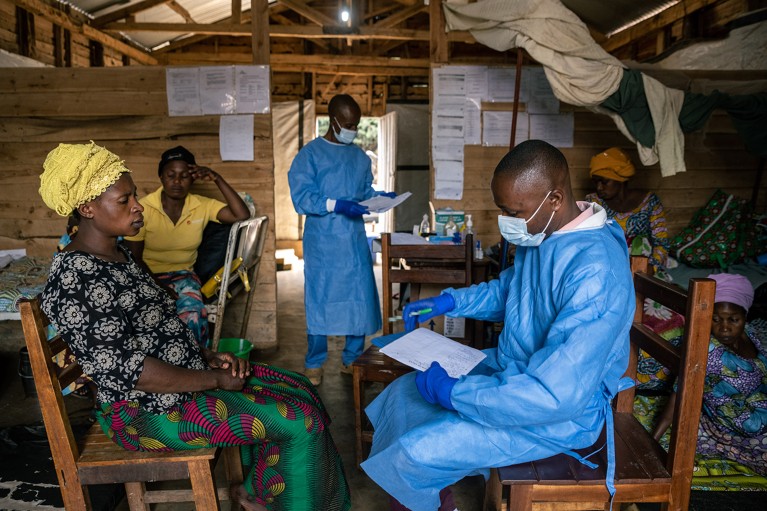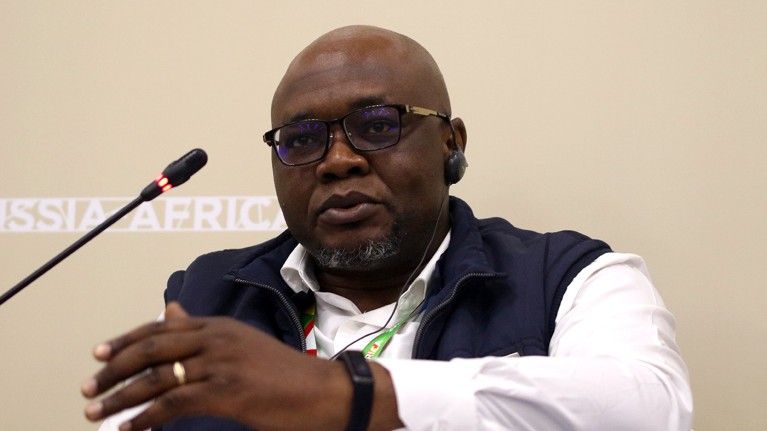
A physician meets with a person being treated for mpox at a hospital in the Democratic Republic of the Congo.Credit: Arlette Bashizi/Bloomberg via Getty
Mpox has spread to 15 African countries in 2024, six of which had never seen a single case of the disease, leaving health officials scrambling to contain the continent’s deadliest mpox surge to date. But they finally have a new tool to help — vaccines — which have not previously been available in Africa despite mpox being detected on the continent decades ago.
Mpox vaccines used in wealthy nations such as Germany and the United States did not materialize in Africa, even during a global outbreak of the disease in 2022, says Nicaise Ndembi, a virologist at the Africa Centres for Disease Control and Prevention in Addis Ababa. This year, however, doses have begun to arrive, after the World Health Organization declared mpox a global public-health emergency for the second time in history.
On 17 September, Rwandan health officials began administering jabs to those at high risk of infection; the Democratic Republic of the Congo (DRC), which has been the African country hardest hit by the disease, will follow suit on 5 October; and Nigeria is set to start its own vaccinations in the next two weeks.

Virologist Nicaise Ndembi is coordinating the mpox response for Africa’s Centres for Disease Control and Prevention. Credit: Russian Look via ZUMA Press
These developments come as African countries report more than 31,400 suspected mpox infections and 844 deaths in 2024. They also come as a new strain of the virus that causes mpox, called clade Ib, has spread in densely-populated regions and partly through sexual contact, meaning that it can transmit from person to person efficiently.
It isn’t yet known how effective the vaccines being handed out will be against clade I virus — they helped during the global outbreak two years ago, but that crisis was driven by a different strain called clade IIb. Still, many scientists emphasize that they are safe and expect them to work.
Here, Ndembi, who is coordinating Africa CDC’s mpox response, talks about how health officials plan to distribute the new doses and the challenges they will face.
Are the doses you’re receiving what you would have expected as part of an equitable global response during the 2022 global outbreak?
We are doing much better. There are about 275,000 doses that we currently have on hand, and they have already been dispatched to countries for administering. In the 2022 pandemic, we didn’t get a single dose of vaccine.
If you put together the pledges and what’s already been delivered, there are about 6.1 million doses coming. But you can’t vaccinate with pledges: the 10,000 doses that Nigeria received in 2024 were actually pledged in 2022. So you can see the disparities. But to now have 6.1 million doses pledged is incredible. Now, we need to see them materialize.
We’re looking at vaccinating 10 million people [in Africa], but that number might need to be as high as 14 or 15 million.
Until more doses arrive, how will countries prioritize who gets shots first?
This is not a vaccination campaign. The messaging around the word, ‘campaign’, connotes that everyone can get a shot. But we’re going to be very targeted. We’re hoping to reach specific groups, and we are envisaging that this approach could create problems within the community if we don’t communicate properly who is most at risk of infection and why we’re prioritizing certain groups. We see that many people are waiting for the vaccine — it’s a silver bullet to many. The stigma coming with mpox [which causes visible, fluid-filled lesions among other symptoms] means everyone wants to get vaccinated.
As an example of prioritizing specific groups, Rwanda has started vaccination, and it’s very targeted among female sex workers and among cross-border traders, truck drivers and healthcare workers — those at high risk [of infection]. We will also use a ‘ring vaccination’ approach: we will identify close contacts of infected people, and those are who you’d want to be sure to vaccinate first.
The DRC is contending with outbreaks of multiple strains of virus — clade Ib, as well as clade Ia, which typically has spread to people through infected animals. Will that affect how vaccines are distributed?
We will start with the hotspots: the provinces that are most affected are going to be selected in the first bloc, and then subsequently we will move on to other areas.
For the different subtypes of the virus, I want to be very clear: viruses don’t have boundaries. We have to move away from the idea that we could confine an [mpox] subtype in a geographic area. [DRC’s capital city] Kinshasa has both clade Ia and Ib.
We’re not going to say ‘let’s start vaccinating the clade Ib areas and then go to the Ia areas’. That would be too complex.
Kinshasa is the entry and exit point for almost all travellers [coming through the region]. There’s definitely worry, because infections there can easily be transported anywhere in the world.
How will you monitor the effectiveness of the vaccines as people receive them?
We have a team already in Rwanda that is working to ensure that we monitor for adverse events and that over time those vaccines are effective. They will study the immunogenicity, safety and effectiveness, as well as durability [how long the vaccine’s effects last].
[Editor’s note: one clinical trial will aim to recruit more than 1,500 people over the age of 10 in the DRC, Uganda and Nigeria with confirmed mpox infections to understand if the vaccines can reduce the risk of their contacts developing the disease or lessen the severity of their illness.]
What would success look like?
In the DRC, we’re dealing with a country of 100 million people. We’re talking about over 30,000 suspected cases — and consider, how many people are even able to get tested? Currently, about 40% of suspected cases get tested, and about 60% of those are positive. That means we’re not testing a lot, and we still have people out there that are moving with the virus who don’t even know they’re infected.
You are controlling an epidemic when new cases stop coming from the contacts of those who you know are infected. Vaccines are meant to help break those chains of transmission — so that’s something we’ll be looking for.
But vaccination is just one of the tools in the response: risk communication, community engagement, laboratory [infrastructure] are equally important.
What has been most difficult about controlling this outbreak?
First, mpox is endemic in some parts of Africa. Within the DRC, there are provinces that have been reporting cases for decades. We don’t have enough tools to rapidly detect the virus. For HIV, you have five minutes, you get the test done, and the result is 99% accurate. If we had a test [like we do with HIV], that would be fantastic.
The other challenge is drugs. Tecovirimat [an antiviral against mpox] worked for clade II during the 2022 pandemic, but it has been shown to be less effective on the African population in the DRC. And lastly, we haven’t had enough vaccines. This is a very strong case for local manufacturing across the continent: we need to start making the diagnostic kits, the drugs and even the vaccines here.

